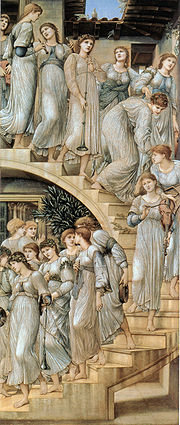 Sir Edward Coley Burne-Jones, 1st Baronet (28 August 1833 – 17 June 1898)
Sir Edward Coley Burne-Jones, 1st Baronet (28 August 1833 – 17 June 1898)was a British artist and designer closely associated with the later phase of the Pre-Raphaelite movement,
who worked closely with William Morris on a wide range of decorative arts as a founding partner in Morris, Marshall, Faulkner, and Company.
Burne-Jones was closely involved in the rejuvenation of the tradition of stained glass art in England.

Aesthetics
Burne-Jones's paintings were one strand in the evolving tapestry of Aestheticism from the 1860s through the 1880s, which considered that art should be valued as an object of beauty engendering a sensual response, rather than for the story or moral implicit in the subject matter. In many ways this was antithetical to the ideals of Ruskin and the early Pre-Raphaelites.
Burne-Jones's aim in art is best given in some of his own words, written to a friend:
I mean by a picture a beautiful, romantic dream of something that never was, never will be - in a light better than any light that ever shone - in a land no one can define or remember, only desire - and the forms divinely beautiful - and then I wake up, with the waking of Brynhild.









 No artist was ever more true to his aim. Ideals resolutely pursued are apt to provoke the resentment of the world, and Burne-Jones encountered, endured and conquered an extraordinary amount of angry criticism.
No artist was ever more true to his aim. Ideals resolutely pursued are apt to provoke the resentment of the world, and Burne-Jones encountered, endured and conquered an extraordinary amount of angry criticism.In so far as this was directed against the lack of realism in his pictures, it was beside the point. The earth, the sky, the rocks, the trees, the men and women of Burne-Jones are not those of this world; but they are themselves a world, consistent with itself, and having therefore its own reality. Charged with the beauty and with the strangeness of dreams,
it has nothing of a dream's incoherence.
Yet it is a dreamer always whose nature penetrates these works, a nature out of sympathy with struggle and strenuous action. Burne-Jones's men and women are dreamers too. It was this which, more than anything else, estranged him from the age into which he was born.
Burne-Jones exerted a considerable influence on British painting.
Burne-Jones was also highly influential among French symbolist painters, from 1889.
His work inspired poetry by Swinburne —
Swinburne's 1886 Poems & Ballads is dedicated to Burne-Jones.
On 16 June 1933, Prime Minister Stanley Baldwin, a nephew of Burne-Jones, officially opened the centenary exhibition featuring Burne-Jones's drawings and paintings at the Tate Gallery in London.
In his opening speech at the exhibition, Mr Baldwin expressed what the art of Burne-Jones stood for:
In my view, what he did for us common people was to open, as never had been opened before, magic casements of a land of faery in which he lived throughout his life ...
It is in that inner world we can cherish in peace, beauty which he has left us and in which there is peace at least for ourselves.
The few of us who knew him and loved him well, always keep him in our hearts, but his work will go on long after we have passed away.
It may give its message in one generation to a few or in other to many more, but there it will be for ever for those who seek in their generation, for beauty and for those who can recognise and reverence a great man, and a great artist.
In his opening speech at the exhibition, Mr Baldwin expressed what the art of Burne-Jones stood for:
In my view, what he did for us common people was to open, as never had been opened before, magic casements of a land of faery in which he lived throughout his life ...
It is in that inner world we can cherish in peace, beauty which he has left us and in which there is peace at least for ourselves.
The few of us who knew him and loved him well, always keep him in our hearts, but his work will go on long after we have passed away.
It may give its message in one generation to a few or in other to many more, but there it will be for ever for those who seek in their generation, for beauty and for those who can recognise and reverence a great man, and a great artist.


2 comments:
You have some dreamy images here. Lovely blog!
Thank you for taking the time to post ...mwah love & light Trace x
Post a Comment